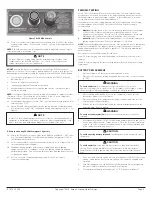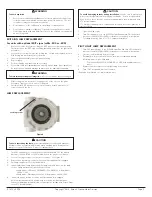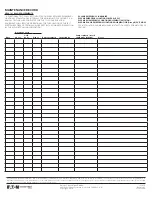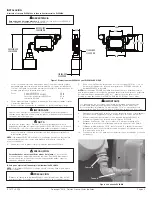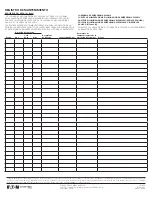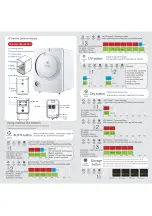
IF 1875 • 03/19 Copyright
®
2019, Eaton’s Crouse-Hinds Division
Page 4
20. Close cover and securely tighten all cover bolts and nuts to 25-30 ft.-lbs. torque,
making certain that no cover bolts are omitted. Use only bolts supplied with the
enclosure.
NOTE:
ELPSM2 units have two (2) stud bolts located at diagonally opposite corners
of the body to aid in positioning cover.
DO NOT
depress the push-to-test pushbutton until after the ELPSM2 has been
powered for 15 hours. The emergency battery requires 15 hours to fully charge. The
indicating light will illuminate steadily (no pulsing) when the ELPSM2 is fully charged.
21. Test emergency lighting system for proper operation (see Table 1 for detail
indication logic).
i)
Turn on the AC power and observe:
•
Indicating light marked ON should be operating.
•
Momentarily press the push-to-test button and observe – emergency lights
should be operating.
NOTE:
If emergency lights do not operate initially, allow battery to charge for at least
15 minutes or more, then repeat the test procedure. Allow 15 hours charge time
before depending on battery to operate at full capacity.
22. Lock designated disconnect switch “ON” to prevent unauthorized persons from
turning system “OFF”.
23. Adjust EVLAM2 emergency light(s) for the desired direction of illumination and
lock into position using 1-5/8” open-ended wrench and torquing to 58 lb.-ft. See
Figure 2.
E. Remote mounting EVLAM2 emergency light only
24. Attach the EVLAM2 to a Crouse-Hinds series EABC36 or EABL36 1” NPT outlet
box. The reducer bushing of the EVLAM2 shall engage a minimum of five (5)
full threads with the outlet box.
25. Secure this assembly to the mounting surface with 1/4” bolts or lag screws of
the required length (not supplied).
26. Maximum running distance between power supply and remote lighting
equipment to be 100 ft. regardless of wire size, lighting equipment load and
ambient temperature. This will ensure limited voltage drop and proper function
of lighting equipment.
27. Refer to Section B for aiming adjustments and Section C for conduit
connections and wiring.
Figure 5. ELPSM20 Controls
!
NOTE
A Class I, Division 1 sealing fitting must be installed within 18 inches of the
conduit entry of the ELPSM2 enclosure. Use Chico A or Chico SpeedSeal
sealing compound to seal the conduit entry.
!
NOTE
In Class II, Class III and Simultaneous Presence locations, limit upward aiming of
equipment to a maximum of 30º above horizontal. Greater upward aiming could
lead to excessive dust build-up and dangerous overheating of the dust.
PERIODIC TESTING
Article 700 of the National Electrical Code states that, “Systems shall be tested
periodically on a schedule acceptable to the authority having jurisdiction to assure
their maintenance in proper operating condition.” It also states that, “A written
record shall be kept of such tests and maintenance.”
In the absence of periodic testing requirements by a local authority, the following
recommendations from the NFPA 101 (2003) Life Safety Code are strongly
recommended:
1.
Monthly:
Operate “push-to-test” switch and keep depressed for a minimum
of 30 seconds. Observe that emergency lighting equipment is on full
brightness for the full time. Record the test on the maintenance record card.
Maintenance Record Card is provided in instruction sheet envelope.
2.
Annually:
Shut off power at the distribution panel. Verify that the emergency
lighting equipment remains “ON” for a minimum of 1-1/2 hours.
NOTE:
Leave the designated disconnect switch “ON” during this test so that battery
circuit is not interrupted. We suggest that this test be continued until the power
supply automatically shuts the emergency light(s) off. This will help maintain full
battery capacity.
Record the test on the Maintenance Record Card.
Allow 15 hours charging time before depending on the battery to operate at full
capacity.
Failure to function properly in either test may indicate the need for battery or lamp
replacement.
BATTERY REPLACEMENT
1.
Disconnect branch AC power at circuit breaker and lockout.
2.
Disconnect DC power by turning designated disconnect key or selector switch
to “OFF”.
3.
After removing all AC and DC power to the equipment, remove all cover
fasteners to gain access to the interior.
4.
Disconnect battery from charger board via plug connector and from selector
switch via 2-pole Wago terminals.
5.
Remove the two (2) screws that fasten the battery hold-down bracket to the
mounting plate. Remove battery.
6.
Re-install battery (part no. TEIG T-SC1800) using hold-down bracket and two (2)
screws previously removed. Torque screws to 20 in.-lbs. Reconnect battery in
series to the selector switch via red battery lead to 2-pole Wago terminals and
to the charger board via plug connector.
7.
Close cover and securely tighten all cover bolts and nuts to 25-30 ft.-lbs. torque,
making certain that no cover bolts are omitted. Use only bolts supplied with
enclosure.
8.
Turn ON supply power to the ELPSM2 Light-Pak and turn ON the designated
disconnect switch located next to the push-to-test button.
9.
Test replacement battery following Step 4 of “D. Complete installation.”
!
WARNING
To avoid explosion,
do not damage the flat joint surfaces. Do not use
hammers or prying tools to open covers. Do not handle covers roughly, or place
them on surfaces that might damage or scratch the flat joint surfaces.
!
WARNING
To avoid potential explosion,
do not short circuit the battery or connector
terminals.
!
CAUTION
To avoid exposing battery terminals,
insulating sheet must completely cover
the battery.
!
CAUTION
To avoid explosion,
clean both flat joint surfaces of body and cover before
closing. Dirt or foreign material must not accumulate on flat joint surfaces.
Surfaces must seat fully against each other to provide a proper explosionproof
seal.




